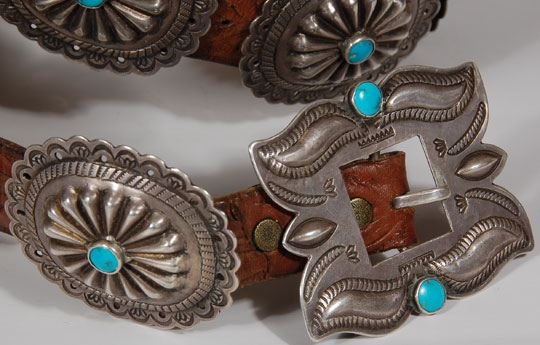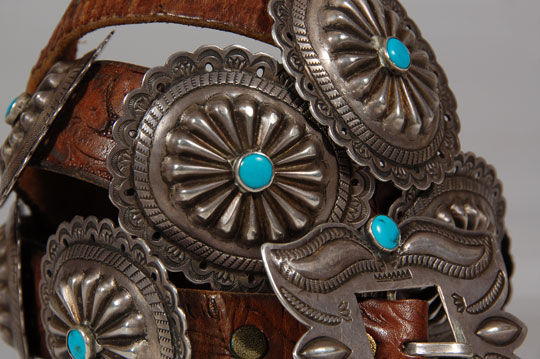Diné (Navajo) Silver and Turquoise Old Concha Belt [SOLD]
+ Add to my watchlist Forward to Friend
- Category: Belts and Buckles
- Origin: Diné of the Navajo Nation
- Medium: silver, turquoise, leather
- Size: 36-1/4” long belt; 2-3/16” x 2-5/8” each concha; 2-3/4” x 2-3/8” buckle
- Item # C3237F SOLD

This fine old concha belt is chisel-stamped repoussé and filed. Each of the 10 conchas features a sunburst at its dome capped with a single blue turquoise cab secured in a silver bezel. The buckle is also of the same construction with two turquoise cabs. This style is the epitome of the finest concha belts made in the mid-20th century. The conchas are not overbearingly large and each is attached to the leather belt with a copper sleeve.
Silver jewelry from the early- to mid-20th century was still being produced by many Navajo at home in their hogans. There was no widespread production by Natives working for outlets such as The Fred Harvey Company using company-supplied materials. Belts such as this one were most certainly made by an individual silversmith and possibly sold to a trading post or dealer or an individual collector. The early interest by tourists was a stimulus to fine craftsmanship. It was only in the 1970s that quality gave way to quantity.
Condition: the belt is in excellent condition
Provenance: from the collection of the Balcomb family
Recommended Reading: Indian Silver Jewelry of the Southwest 1868-1930 by Larry Frank
Concho or Concha? You will hear both words (we say concha), but they refer to the same thing. Some history: The word concho comes from the Spanish "concha" which actually means "conch" or "seashell" but has come to mean round, domed, or oval disks of silver used to decorate horse saddles or bridles and even on clothing. It's also seen as jewelry such as pendants, pins and even bolo ties. What is most striking is when it's seen adorning leather belts.
Concha belts are a long-time Navajo tradition yet it has been suggested (unknown source) that the Navajo borrowed conchas from Mexican tack items or from the Plains Indians. The earliest conchas were silver dollars (coin silver) that were hammered, then stamped and edged, then slotted and strung together on a piece of leather. Eventually, copper loops were added to the back of the conchas so that they could be slipped onto a leather belt.
Features of a Concha Belt: Concha belts can be a continuous row of conchas or could have spacers in between the conchas. The spacers can be of various shapes but traditionally are butterflies and it is easy to see why they are called that when you look at their shape.
The conchas and butterflies are sometimes backed by leather which highlights the silver work and also protects the edges of the silver from bumping, wear or bending.
Can a man or a woman wear a concha belt? Concha belts are unisex and can be worn with jeans as well as dresses. It is very "Santa Fe" to add a one to one's attire and can even be included with any clothing that is black in color. When this is done, this creates what is considered "Santa Fe Formal" wear and is usually very stunning. This approach really draws attention to the wearer's concha belt and oftentimes, great conversation.

- Category: Belts and Buckles
- Origin: Diné of the Navajo Nation
- Medium: silver, turquoise, leather
- Size: 36-1/4” long belt; 2-3/16” x 2-5/8” each concha; 2-3/4” x 2-3/8” buckle
- Item # C3237F SOLD



